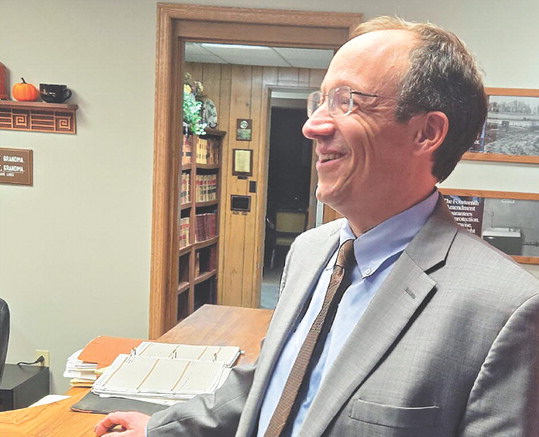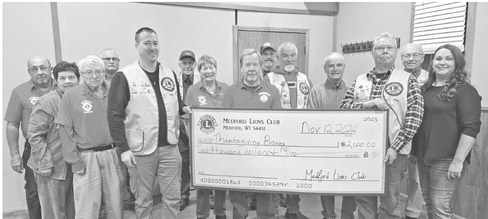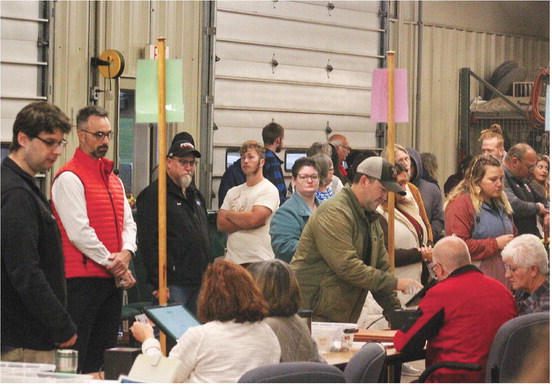County is limited in restricting wind farms
Marathon County officials were told last week that state law prevents them from restricting or regulating large-scale wind farms beyond what the Public Service Commission (PSC) does.
Members of the Environmental Resources Committee spoke May 2 with Stacy Schumacher, a policy advisor at the Wisconsin PSC, about the state’s role in reviewing and approving permits for wind farms like the one proposed in western Marathon County. Invenergy, a Chicagobased company, is interested in starting a 150-megawatt project, which would fall solely within the jurisdiction of the PSC, based on current state law.
Under PSC code 128, all proposed wind power operations with a capacity of 100 MW or more must obtain what’s called a Certificate of Public Convenience and Necessity (CPCN) from the state commission. The PSC’s approval of these permits cannot be precluded by local ordinances, according to information provided to the committee.
During public comment, however, attorney Martin Machtan from the Marshfield area said he and other lawyers believe that local units of government can, in fact, enforce more restrictive regulations. The town of Johnson recently adopted a “public health and safety licensing ordinance” that applies to wind turbines, he said, and within the next month, up to 24 more townships are poised to adopt similar ordinances.
“This, to me, is an issue over which we have significant control,” he said. “I think we need to exercise it.”
Machtan is a member of Farmland First, a group of rural Marathon and Clark County residents who are speaking out against two industrial wind farms proposed for the area. He said he initially supported wind-generated power, until he started reviewing contracts presented by wind companies to landowners, which he called the most “imbalanced, unfair and one-sided contracts” he had ever seen.
“I see these deals as shifting a ton of liability onto landowners, not providing a lot of compensation to them and externalizing all sorts of costs to our communities,” he said.
Besides the legal perils for landowners, Machtan said the wind farms represent a “disastrous land-use policy” that threatens to increase energy prices and decrease the reliability of Wisconsin’s energy grid.
“We’re just trying to sound the alarm that these projects generally do not make sense,” he said.
Machtan said Farmland First is seeing a lot of support among township residents for more wind turbine restrictions, even if it means the possibility of legal action by the energy companies.
“You guys have a lot of say, and I think now is the time to be bold,” he told the committee.
Also during public comment, Wausau area resident Ron Lutz shared he and wife’s experience living next to a wind turbine, which he called “unbearably loud” and detrimental to their health and well-being.
“The noise has ruined our outside surroundings and invaded and destroyed our dream home,” he said.
Lutz said he and his wife wear ear plugs and run fans and white noise machines to drown out the sound inside their house, but he worries that the nuisance will devalue their property and make it harder to sell. He said they tried adding four inches of insulation to their attic, but it didn’t help, and as a result of the constant noise, they suffer from sleeplessness, fatigue and anxiety.
“The wind turbine noise is real, unnervingly disturbing and substantially beyond all normalcy,” he said.
Rules explained
Shad Harvey, land resources manager for Conservation, Zoning and Planning, told the committee that Chapter 17.405 of the county’s ordinance regulates wind operations that generate up to 99 megawatts of electricity.
Chapter 17.405 says wind farm applicants must provide a site plan, construction timelines and a description of impacts on local infrastructure. It also lays out processes for appealing the county’s decisions, submitting complaints and providing compensation to landowners.
However, the opening line of the ordinance makes it clear that it incorporates all the state’s rules “on the installation, siting, use, and decommissioning of wind energy systems.” This includes a maximum setback of 1,250 feet from neighboring properties and a noise limit of 50 decibels during the day and 45 at night. The ordinance also says it exists to “preserve and protect public health, safety, and welfare.”
Any wind energy operation with a capacity over 300 kilowatts must obtain a conditional use permit from the county’s board of adjustment in order to operate in the following zoning districts: farmland preservation, general agricultural, conservancy/recreation and heavy or light industrial.
The board may set conditions for operation of the wind turbines, but they cannot be more restrictive than what state law allows, according to information provided to the committee.
“In terms of your conditional use permit or whatever zoning permit process you have, that is usually superseded by this statute,” Schumacher told the committee.
For proposed wind farms with a capacity of 100 MW or more, the decision to grant the CPCN ultimately comes down to three PSC commissioners, based on information provided by commission staff members, Schumacher said. For context, she said a wind project above that threshold has not come before the PSC since 2011.
From the time it receives an application, the PSC has 30 days to determine if the application is complete; once that is confirmed, the commission has up to 360 days to approve or deny the project. Invenergy has not yet submitted an application for a wind farm in Marathon County.
According to state statute, the PSC must consider several factors when evaluating a wind farm application, such as whether its design and location are in the public interest; whether the operation will have an “undue adverse impact” on the environment, and whether it will “unreasonably interfere with the orderly land use and development plans for the area.” The commission is supposed to evaluate alternate locations for wind turbines and take into account “public health and welfare” and “the aesthetics of land and water,” among other factors.
Public hearings are required as part of the PSC’s review process, and Schumacher said testimony and written comments from citizens can be used when weighing the qualifications of the proposal. Local units of government can also register as “intervenors,” which grants them greater involvement in the process, she said.
Schumacher also described the state’s process for updating its wind farm rules on a periodic basis, which is led by a special wind siting council. The council relies on the latest peerreviewed health studies when submitting a report to the legislature every five years, but it missed the last deadline in 2019, so the next report isn’t expected until 2024, she said.
Committee members were sympathetic to the concerns of landowners, especially when it comes to the noise nuisance described by Lutz.
“If I had that in my backyard, I’d be out of that house so quickly,” said supervisor Dave Overbeck. However, he questioned why the issue was on the committee’s agenda if the county is powerless to change the rules.
“It’s out of our hands, and that should be made clear to the general public,” he said.
Chairman Jacob Langenhahn acknowledged that the county does not have any control over wind power operations with a capacity over 100 MW.
“If it’s above that threshold, we cannot deny this. It is clear in the rules,” he said. “Therefore, I think we need to look at what we can control in all of this and have an honest discussion about that.”
Langenhahn was skeptical about the impact of a county resolution calling for state law changes, but he encouraged supervisors and others to contact state legislators directly.
“If they get 100 calls about a particular issue, they’re going to pay attention,” he said.




